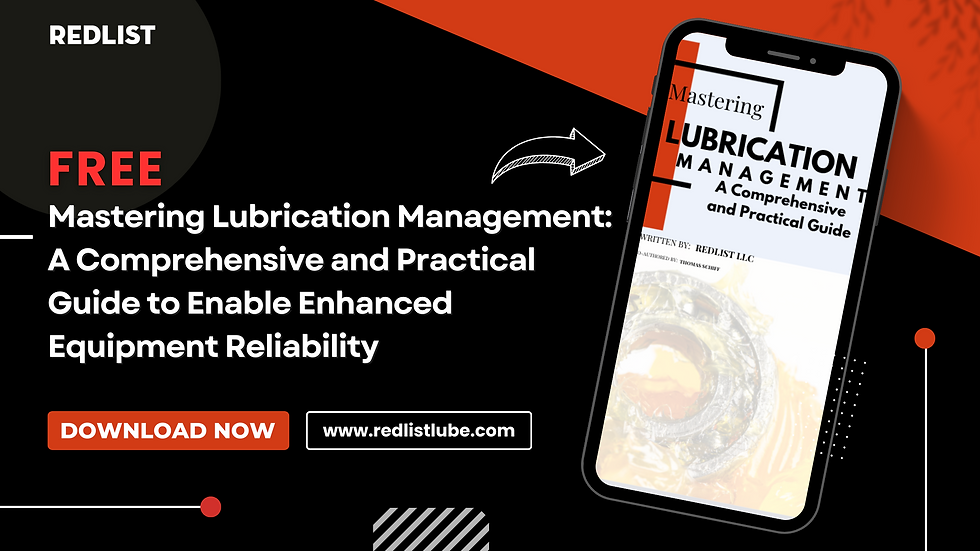Unlocking the Power of Lubrication and Preventive Maintenance
- Redlist
- May 13, 2024
- 3 min read
Updated: Aug 6, 2024

Lubrication and preventive maintenance (PM) are two of the most critical areas of asset management. They are interrelated and one impacts the other. Effective and robust lubrication and PM programs provide valuable benefits, such as preventing costly asset failures, improving the efficiency of operations, and extending asset lifespan.
In this post, we take a closer look at lubrication and preventive maintenance. Understanding the essentials of both concepts will help you use them to your benefit successfully.
What are Lubrication and Preventive Maintenance?
Lubrication is the process of applying grease, oil, or any lubricant to prevent wear and tear, overheating, and corrosion. Preventive maintenance is any step, such as inspections or repairs, that you complete to prevent or delay failure.
The goal of preventive maintenance is to maintain an asset’s optimal performance. PM strategies can include lubrication tasks, and lubrication can be a form of preventive maintenance.

Lubrication as Preventive Maintenance
Lubrication plays a crucial role in PM strategies through the following ways:
Reducing Friction and Wear
Lubricants create a barrier between moving parts, thus reducing friction and preventing the resulting wear on these components.
Dissipating Heat
Lubricants help dissipate the heat produced by the friction between moving parts that meet each other. This is crucial for preventing overheating and heat-related component damage.
Preventing Corrosion
Lubricants create a barrier that can protect against moisture and contamination. Both factors lead to the corrosion of metal surfaces, making them essential for preventive maintenance.
Maintaining Seal Integrity
Lubricants help keep gaskets and seals intact, preventing leaks and the resulting machine or asset failure.
Preventive Lubrication Activities
Although lubrication is part of PM programs, not all lubrication activities can count as a preventive maintenance measure. The following lubrication activities are preventive:
Regular Lubrication Schedule
Applying oil or grease when there are already signs of friction or damage such as noise, misaligned parts, etc. is not preventive. You can prevent these issues and other symptoms by applying lubricants on a regular schedule following the manufacturer’s recommendations and as required by your operations.
Keep in mind that excessive lubrication can happen if you do not monitor your equipment's condition and track your lubricant usage.
Lubricant Selection
Selecting the appropriate lubricant can also be a form of preventive lubrication. By doing so, you ensure that the correct lubricant type and grade are used for the right asset type, operating conditions, and other factors.
Lubricant Application
The correct process of lubricant application has a major impact on the preventive benefits of lubrication against failures and breakdowns. A lubricant that works best in preventing failure is one that you apply at the right amount, location, and frequency.
Contamination Control
Controlling contamination is another preventive lubrication activity that involves keeping lubrication points clean. By protecting these points from moisture, dust, and other contaminants, you decrease the formation of chemicals that promote surface damage and component failure.
Monitoring and Inspection
Regular lubricant condition monitoring involves visual inspections, oil analysis, and other methods. These methods ensure that any lubricant in use remains effective. Routine inspection of machine or asset components helps you identify early signs of component damage and resolve them before they lead to bigger problems.
Mapping and Labeling Lubrication Points
Properly mapped and labeled lubrication points prevent lubrication errors and optimize lubrication benefits. Another benefit is that there is less time spent locating lubrication points and reduced risk of overlooking one.
Inventory Management
Proper storage and handling of lubricants is critical for effective lubrication. Lubricant inventories must be stored and handled in ideal conditions to prevent contamination, exposure to the elements, and other factors that decrease their performance.
Training and Education
Proper collection, use, and transfer of lubrication information–also known as knowledge management–is critical for lubrication to be an effective preventive maintenance measure.
Lubrication technicians or personnel must spend hours training and gain valuable first-hand experience to ensure effective preventive lubrication results.
Lubrication and Preventive Maintenance Support from Redlist
The complicated processes involved in lubrication and preventive maintenance programs can benefit from a management system like Redlist. Redlist offers both a Computerized Maintenance Management System (CMMS) and a Lubrication Management Software (LMS).
These platforms digitize information and streamline maintenance processes like those involved in lubrication and preventive maintenance.
First, Redlist helps with scheduling lubrication and other maintenance tasks, ensuring that all tasks are performed on time to prevent equipment failure. Next, Redlist helps with knowledge management by serving as a centralized database for asset information and maintenance history.
Furthermore, Redlist can send alerts and notifications to its users for upcoming lubrication tasks, inspections, or lubricant changing or replenishment. You can also use Redlist to set inventory stock level alerts to inform you when lubricant stocks are low or near expiration dates, thus preventing stock outs and delays in lubrication activities.
Finally, Redlist is equipped with powerful analytics to evaluate the effectiveness of lubrication and preventive maintenance. It can create reports on lubrication trends, areas of improvement, or failure signs.
Thus, you can make informed decisions to improve asset reliability. You can now experience innovative technological support from Redlist’s CMMS and Lubrication Management Software. Contact us for a free demo today!


Commentaires